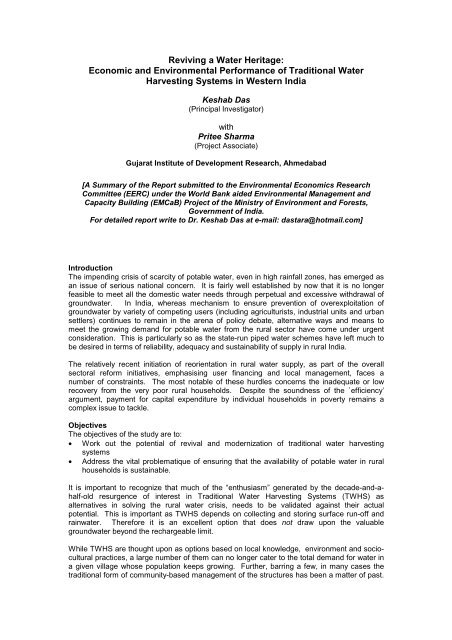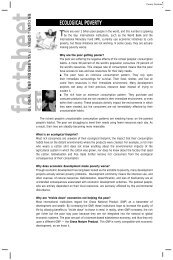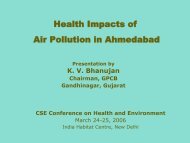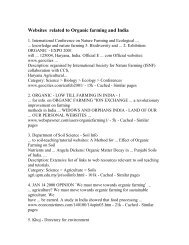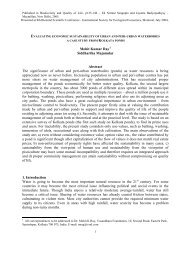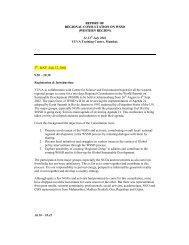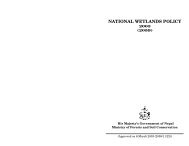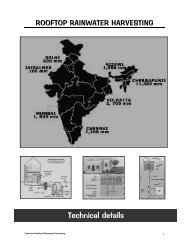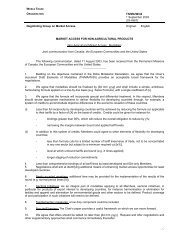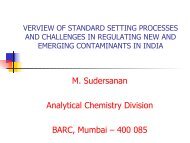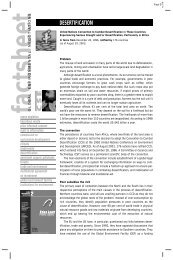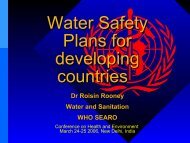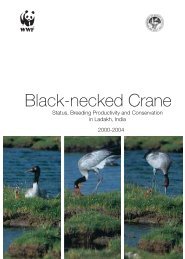Reviving a Water Heritage: - Rainwater Harvesting
Reviving a Water Heritage: - Rainwater Harvesting
Reviving a Water Heritage: - Rainwater Harvesting
Create successful ePaper yourself
Turn your PDF publications into a flip-book with our unique Google optimized e-Paper software.
<strong>Reviving</strong> a <strong>Water</strong> <strong>Heritage</strong>:<br />
Economic and Environmental Performance of Traditional <strong>Water</strong><br />
<strong>Harvesting</strong> Systems in Western India<br />
Keshab Das<br />
(Principal Investigator)<br />
with<br />
Pritee Sharma<br />
(Project Associate)<br />
Gujarat Institute of Development Research, Ahmedabad<br />
[A Summary of the Report submitted to the Environmental Economics Research<br />
Committee (EERC) under the World Bank aided Environmental Management and<br />
Capacity Building (EMCaB) Project of the Ministry of Environment and Forests,<br />
Government of India.<br />
For detailed report write to Dr. Keshab Das at e-mail: dastara@hotmail.com]<br />
Introduction<br />
The impending crisis of scarcity of potable water, even in high rainfall zones, has emerged as<br />
an issue of serious national concern. It is fairly well established by now that it is no longer<br />
feasible to meet all the domestic water needs through perpetual and excessive withdrawal of<br />
groundwater. In India, whereas mechanism to ensure prevention of overexploitation of<br />
groundwater by variety of competing users (including agriculturists, industrial units and urban<br />
settlers) continues to remain in the arena of policy debate, alternative ways and means to<br />
meet the growing demand for potable water from the rural sector have come under urgent<br />
consideration. This is particularly so as the state-run piped water schemes have left much to<br />
be desired in terms of reliability, adequacy and sustainability of supply in rural India.<br />
The relatively recent initiation of reorientation in rural water supply, as part of the overall<br />
sectoral reform initiatives, emphasising user financing and local management, faces a<br />
number of constraints. The most notable of these hurdles concerns the inadequate or low<br />
recovery from the very poor rural households. Despite the soundness of the `efficiency’<br />
argument, payment for capital expenditure by individual households in poverty remains a<br />
complex issue to tackle.<br />
Objectives<br />
The objectives of the study are to:<br />
• Work out the potential of revival and modernization of traditional water harvesting<br />
systems<br />
• Address the vital problematique of ensuring that the availability of potable water in rural<br />
households is sustainable.<br />
It is important to recognize that much of the “enthusiasm” generated by the decade-and-ahalf-old<br />
resurgence of interest in Traditional <strong>Water</strong> <strong>Harvesting</strong> Systems (TWHS) as<br />
alternatives in solving the rural water crisis, needs to be validated against their actual<br />
potential. This is important as TWHS depends on collecting and storing surface run-off and<br />
rainwater. Therefore it is an excellent option that does not draw upon the valuable<br />
groundwater beyond the rechargeable limit.<br />
While TWHS are thought upon as options based on local knowledge, environment and sociocultural<br />
practices, a large number of them can no longer cater to the total demand for water in<br />
a given village whose population keeps growing. Further, barring a few, in many cases the<br />
traditional form of community-based management of the structures has been a matter of past.
Gross neglect of these common property resources is evident in the existence of damaged<br />
structures, pollution of the water and even forcible possession by vested interests for private<br />
purposes.<br />
Despite the indifference meted out to these age-old structures in many regions, especially<br />
when attention centred around the solution that was expected to come about through the<br />
modern piped water system, TWHS continue to function in numerous villages of India and if<br />
not fully, these sources could fulfil demand for water for domestic use partially, particularly<br />
during the summer months.<br />
Sites<br />
In view of the rather limited and sketchy literature available on TWHS (meant mainly for<br />
drinking water purpose) and the growing need to appreciate their environmental and<br />
economic performance this study concentrated on three distinct TWHS as extensively found<br />
in the Thar Desert and Central Uplands Regions. The systems studied are bavdis in western<br />
Madhya Pradesh, wells (which are primarily recharged by nadis) in western Rajasthan and<br />
talavs in Kutch region of Gujarat.<br />
Bavdis or the community step wells are shallower than wells, they have beautiful arches along<br />
their full height. Bavdis can hold water for a long time because of almost negligible water<br />
evaporation when compared to other water bodies. A nadi is essentially a natural surface<br />
depression, which receives rainwater from one or more directions. Some nadis have<br />
stonewalls on one or two sides to enhance capacity of water retention. A talav is a local<br />
water reservoir situated in valleys and natural depressions. In old talavs, only the slope side<br />
was provided with strong parapet walls to hold the rainwater. Other sides were naturally<br />
supported by outcrops of hillocks or elevated rocky formations.<br />
Methodology<br />
Three distinct approaches were followed:<br />
Hydrogeological and engineering surveys were undertaken to understand the functional<br />
dynamics of the systems. These also included exploring possible technical interventions and<br />
modifications needed to improve the existing structures so as to enhance the availability of<br />
water. Estimates of cost of revival/modernization of TWHS were arrived at following these<br />
surveys and consultation with locally informed people, NGOs and concerned engineers and<br />
hydrologists in the local state/taluka department offices. Similarly, estimates were also<br />
prepared for capital expenditure and O&M costs for installing piped water network in the<br />
village, so as to provide tap connection to every household. These sets of estimates were<br />
made for all the six sample villages.<br />
Village and Household level surveys were conducted in order to elicit information on<br />
demographic and socio-economic variables of the inhabitants and availability of infrastructural<br />
facilities. A total of 301 households were surveyed for the purpose. Special care was taken to<br />
obtain as much detailed data as possible on water related issues, such as, sources, pattern of<br />
use, time taken and distance covered to fetch water and perception about quality. The<br />
household and village level structured surveys were supplemented by fairly well attended<br />
focus group discussions, oriented in a manner to understand diverse views as expressed<br />
freely by the participants. The focus group discussions (FGDs) dealt primarily with the ticklish<br />
issues of community ownership and management of the existing TWHS.<br />
The third but vital approach followed in the analysis related to the valuation of popular<br />
willingness to pay (WTP) for provision of facilities of water through improved TWHS and<br />
supplying water through household level tap connections. This exercise was based upon<br />
structured questionnaires prepared following the Contingent Valuation Method (CVM). The<br />
introduction of the option of mode of payment was supposed to help reveal respondents’<br />
actual ability to pay for the amenities.<br />
These exercises in ascertaining households WTP from possible water supply devices,<br />
proposed through the creation of a hypothetical market scenario, provided the most<br />
ii
interesting clues regarding popular perception about the TWHS and/or modern piped water<br />
supply and their readiness to pay for either or both of these systems.<br />
Results<br />
Drawing upon available documentation on TWHS and extensive field surveys in the broad<br />
ecological zones of the Thar Desert and Central Highlands, it is obvious that TWHS not only<br />
vary substantially in terms of technology and management, but also their functioning depends<br />
crucially on the local discrete environment. Keeping these local specificities in view the<br />
potential of selected systems in terms of long-term sustainability can be described in brief, as<br />
follows:<br />
Bavdis in Southwestern Madhya Pradesh: These exist in huge numbers. But, mainly due to<br />
their typically small size and limited storage capacity, these are probably not the best options<br />
for meeting community water needs. However, as observed by the hydro geologists and<br />
water engineers, it is possible to deepen existing talavs and dig new ones that, in turn, would<br />
recharge bavdis. In Dhababavdi (Barwani district) the currently functioning two bavdis serve<br />
a limited purpose and, clearly, cannot address the water scarcity problem of the entire village.<br />
Wells in Western Rajasthan: Wells as TWHS in the western parts of Rajasthan have<br />
continued to prove useful even during summer months in the driest geoclimatic region of<br />
India. Unlike bavdis, wells are extensively used by the rural communities and are well<br />
maintained. All the wells visited in this region during the peak summer season, had good<br />
supply of water and the local perception about its quality was positive. An important hydro<br />
geological characteristic of the wells surveyed was that the structures had been linked to<br />
underground perennial streams/channels. Also, these wells had been built with reference to<br />
the surrounding nadis (TWHS by themselves) so as to receive water recharged through them.<br />
Such ingenious selection of location and construction of the structures ensured a steady<br />
supply of water in the wells. These wells hold much potential to be revived and modernized.<br />
One effective approach would be to desilt, deepen and widen the concerned nadis; this will<br />
ensure a substantial increase in availability of water in the wells, which may be stored for a<br />
long period of time. These structures are also viable options in these regions where piped<br />
water system is most likely to fail due to very low groundwater tables.<br />
Talavs in Kutch, Gujarat: Almost all parts of the Kutch region have suffered substantial<br />
groundwater depletion and salinity ingress. High incidence of poor groundwater bearing<br />
formations has resulted in severe water crisis in the region. Talavs certainly remain an<br />
important solution to the water problem in Kutch. In many villages visited, villagers<br />
considered water from local talavs to be of good quality and that water is available in them<br />
during prolonged spells of summer. The structures in the surveyed villages are unique<br />
examples of interconnected talavs, specially designed to prevent drinking water mingling with<br />
water in other talavs meant for washing or bathing purposes. In terms of size and capacity<br />
talavs are of large dimensions. These are in dire need of revival and modernization and can<br />
surely prove valuable in addressing the water shortage problem in Kutch region. Unlike the<br />
saline groundwater, talavs retain potable water and also recharge surrounding aquifers as<br />
also other TWHS like wells.<br />
<strong>Water</strong> Quality<br />
A commonly held observation disfavouring TWHS as potential sources of potable water<br />
concerns the ‘unprotected’ and ‘unsafe’ nature of the water. This important dimension of<br />
quality of water of TWHS must be taken into consideration in evaluating their potential. <strong>Water</strong><br />
samples from the surveyed TWHS were collected for chemical analyses. Of the seven water<br />
samples collected from individual TWHS, in all the cases the water was found suitable for<br />
drinking; the incidence of total dissolved solids (TDS) was within permissible limits.<br />
Bacteriological analyses of the water samples were also carried out in the laboratory following<br />
scientific instructions. These tests, however, indicated to the unsuitability of the water for<br />
drinking purposes due to the presence of very high concentrations of coliform bacteria.<br />
Irrespective of the fact that most villagers use the water of TWHS for drinking, cooking and<br />
other domestic purposes, these scientific tests indicate deficiencies in water quality. In most<br />
cases, as in the surveyed TWHS, quality of water can be upgraded substantially through cost-<br />
iii
effective methods of treatment. Whether some sources are to be abandoned, primarily due to<br />
lack of any scope to improve water quality, even up to the level of being used for domestic<br />
purposes (other than human drinking) only, should be left exclusively to the discretion of the<br />
scientific experts.<br />
Valuation of TWHS<br />
Whereas hydrogeological and structural engineering studies could work out interventions that<br />
would revive/ modernize the specific TWHS on a long-term sustainability basis, the estimation<br />
of both the capital cost as well as O&M indicates the financial investment that would be<br />
required. Such estimates are likely to represent the total use value of the environmental<br />
‘commodity’ in question. As the analysis concentrates on potable water meant for domestic<br />
consumption only, the existence value of the commodity becomes irrelevant. Also, the nature<br />
of benefits of having access to good quality water is very much within the knowledge of the<br />
potential users. It may, hence, be held that the assessment of WTP undertaken in the study<br />
falls within the broad purview of cost-benefit analysis. Assuming that the entire cost of<br />
revival/ modernization would be shared between all the households in the village, an<br />
assessment of the willingness to pay for the improvised structures was made. The most<br />
significant aspect of the WTP exercise was that a substantial 65 per cent of all households<br />
surveyed were not willing to pay any amount whatsoever for either or both the hypothetically<br />
proposed facilities. Despite having a series of independent variables, indicating the most likely<br />
socio-economic factors, regressed with the amount of WTP, the state level results showed<br />
only per capita consumption of water in Madhya Pradesh and Gujarat and caste of the<br />
household in Gujarat as the significant variables affecting the WTP (Table 1). However, when<br />
similar regressions were run for Rajasthan none of the variables was found to be significant.<br />
Table 1: Overall Summary of Logistic Regression Results<br />
State/ Level of<br />
Significance<br />
1% level of Significance 5% level of Significance 10% level of<br />
Significance<br />
Madhya Pradesh PCHUMQ (1.035)<br />
Rajasthan<br />
Gujarat CASTE (0.174) PCHUMQ (1.049)<br />
In fact, a close examination of the nature and extent of households’ WTP provides interesting<br />
insights into such a pattern of response. First, most households in the Rajasthan villages are<br />
living in extreme poverty and, naturally, have refused to pay at all for the water from either<br />
TWHS or piped systems. The villagers are perfectly aware that the existing wells, from where<br />
they have been drawing water free even during the peak summer months, will continue to<br />
meet their minimum basic demand for potable water. However, if extreme poverty could lead<br />
to negative response for paying for water, in Dhababavdi (the MP village) quite a few villagers<br />
living below the poverty line have expressed their willingness to pay even small sums for<br />
water facilities. This is so, as this village has practically exhausted all existing sources and<br />
the value for water has clearly risen for them.<br />
Second, unlike the capital cost, most villagers in all the surveyed villages were willing to pay<br />
for the O&M for TWHS; in many cases the estimated contribution for O&M for the proposed<br />
piped system was much higher than that for TWHS. People’s willingness to contribute free<br />
labour indicates the preference for the revival/ modernization of the TWHS. Table 2 presents<br />
the proportions of respondents willing to pay for revival of TWHS, laying of piped system,<br />
O&M for both TWHS and pipe network and contribution of free labour across sample villages.<br />
Table 2: Willingness to Pay Across Sample Villages<br />
(Percentages)<br />
iv
Particulars<br />
Madhya Pradesh Rajasthan Gujarat<br />
Dhababavdi Temla Nagana Godavas Tera Reha Mota<br />
WTP TWHS 26.8 11.8 14.3 4.7 77.3 11.8<br />
WTP PIPE 22.0 9.8 5.7 - 18.2 7.8<br />
WTP O&MTWHS 39.0 76.5 97.1 100.0 93.2 90.2<br />
WTP O&MPIPE 29.3 13.7 17.1 - 72.7 13.7<br />
WTP LABOURTWHS 92.7 84.3 97.1 100.0 77.3 74.5<br />
An important aspect of this exercise in assessing WTP is that even the most sophisticated<br />
methods of valuation may be inadequate to elicit information on the WTP behaviour if the<br />
respondents refuse to participate in the `bidding’ process due mainly to abject poverty and<br />
rejecting the very proposal that potable water could be priced for the rural poor.<br />
Recommendations<br />
A number of technological options to revive/ modernize the TWHS have been put forth by the<br />
hydro geological and engineering experts. Most of the considered suggestions have been<br />
highly discrete (specific to the system or site per se) and often have incorporated ideas from<br />
local inhabitants. For instance, as may be seen from Table 3, especially the bavdis may not<br />
prove to be adequate sources of water due to their small size. Table 3 presents brief notes<br />
on suggested technological interventions, which may serve as useful guidelines in<br />
appreciating the utility and sustainability of individual systems.<br />
Table 3: Structural Issues Relating to the Revival of TWHS<br />
Particulars<br />
Structural<br />
Features<br />
Potability<br />
Technological<br />
Interventions<br />
Bavdi Well Talav<br />
Dhababavdi Temla Nagana Godavas Tera Reha Mota<br />
Structure is<br />
Huge<br />
small<br />
capacity and<br />
favourable<br />
Unsuitable<br />
for human<br />
drinking<br />
Desilting of<br />
catchments<br />
would<br />
improve<br />
water table<br />
<strong>Water</strong><br />
unsuitable for<br />
human<br />
drinking<br />
Desilting of<br />
local talav is<br />
essential for<br />
recharge of<br />
the bavdi<br />
Ground<br />
water is<br />
becoming<br />
saline<br />
Desilting of<br />
local talav<br />
would<br />
improve the<br />
water and<br />
reduce<br />
salinity<br />
Increasing<br />
salinity<br />
topography<br />
Used as<br />
potable water<br />
Some people<br />
reported to<br />
have had<br />
diseases<br />
because of<br />
the bacterial<br />
contaminatio<br />
n of the<br />
water during<br />
late summers<br />
Reported to be<br />
unsuitable for<br />
drinking but<br />
good for<br />
cooking<br />
Desilting would<br />
improve the<br />
groundwater<br />
level in the<br />
area<br />
Table 4 presents some relevant issues covering management and maintenance of the TWHS.<br />
In case of the well in Nagana in Rajasthan and the talav in Tera in Gujarat the local<br />
community did management and maintenance of the TWHS. These are the villages where the<br />
use of water from TWHS has been extensive and also the quality of water has been well<br />
maintained. In the remaining cases, a preference has been expressed for complete or partial<br />
involvement of state government in managing and maintaining the sources. In these villages,<br />
the general lack of confidence in the efficacy of the sarpanchs in managing these sources is<br />
v
striking. The possibility of public and private participation in financing the revival of the TWHS<br />
in these villages may be explored.<br />
Table 4: Management Issues in Revival and Maintenance of the TWHS<br />
Bavdi Well Talav<br />
Dhababavdi Temla Nagana Godavas Tera Reha Mota<br />
Presently<br />
privately<br />
owned,<br />
Government<br />
should takeover<br />
& manage<br />
Government/<br />
Panchayat<br />
managed:<br />
Distrust among<br />
the people<br />
regarding the<br />
Panchayat<br />
Managed<br />
Improper local<br />
management<br />
Community<br />
managed<br />
Government<br />
should take up<br />
the<br />
management<br />
Sarpanch is<br />
illiterate: Lack<br />
of leadership<br />
No participation<br />
from women<br />
usage of funds<br />
Lack of<br />
leadership,<br />
Sarpanch<br />
illiterate<br />
Leadership is<br />
caste biased<br />
Women do not<br />
have a say in<br />
the local<br />
management<br />
Lack of sense<br />
of responsibility<br />
for<br />
maintenance of<br />
the existing<br />
structures<br />
The local<br />
leaders are<br />
highly<br />
motivated and<br />
concerned for<br />
the water<br />
management<br />
People are<br />
united for<br />
maintenance<br />
of the system<br />
Generally<br />
people were<br />
not interested<br />
in taking up<br />
the<br />
maintenance<br />
and<br />
management<br />
of their water<br />
supply.<br />
It was apparent that TWHS were not or will not be able to cater to the total requirement of<br />
drinking water in the villages, mainly due to the rise in population in the past decades.<br />
Nevertheless, if revived/ repaired and, importantly, the ownership is shifted from the present<br />
private owner to the original community, these sources can be of substantial use, especially<br />
during summer.<br />
Piped water system, though preferable, has implications of increasing cost in future either due<br />
to increase in population or depletion of groundwater. Additionally, the ubiquitous problem of<br />
unreliability of piped water supply has serious implications for considering alternative sources.<br />
Hydrogeology specific technological strategies to harness rainwater and modernize TWHS<br />
need to be explored as enhanced supply per se can reduce costs significantly. In such<br />
ventures whether and how the State can intervene or shall seek private participation, both for<br />
financing and providing technical and management support is an issue to be explored. In<br />
TWHS, the trickier issue is management with community participation. The control over the<br />
system by the local dominant group is difficult to wish away.<br />
Interestingly, the large-scale prevalence of TWHS in its varied forms in the three states has<br />
not been adequately documented in the rather limited literature on the subject. Locating the<br />
TWHS through the field survey, wherein about 50 such structures were visited, in itself was<br />
an important aspect of the study.<br />
vi


